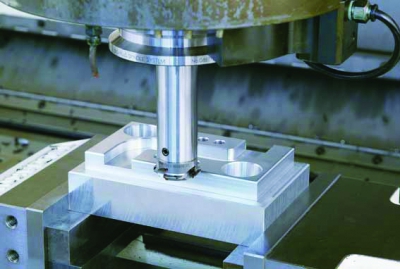
BIG KAISER has introduced the R-Cutter CKB Type, a new modular round chamfering tool. The R-Cutter CKB3 and CKB5 is an ultrahigh-feed front and back radius chamfering mill, which features high rake angles that reduce cutting resistance and minimize burr generation.
The R-Cutter CKB Type offers a unique insert geometry, providing extreme sharpness. The radius chamfering mill is offered as a four-insert design to cut in the tightest of spaces and for higher feed rates.
The CKB connection is equipped with a floating drive pin, which engages on both sides into respective pockets in the mating part. The tapers on the pins and the angles on the pockets are engineered to permit an automatic balancing of the two resulting torsional forces.
Additionally, the CKB connection allows for an array of standard shanks and extensions to be adapted with the heads to create “custom” tools to extend over 16 inches, maintaining damping near the cutting edge and managing vibration in long-overhang setups.
Contact Details
Related Glossary Terms
- burr
burr
Stringy portions of material formed on workpiece edges during machining. Often sharp. Can be removed with hand files, abrasive wheels or belts, wire wheels, abrasive-fiber brushes, waterjet equipment or other methods.
- chamfering
chamfering
Machining a bevel on a workpiece or tool; improves a tool’s entrance into the cut.
- chamfering tool
chamfering tool
Cutter or wheel that creates a beveled edge on a tool or workpiece.
- feed
feed
Rate of change of position of the tool as a whole, relative to the workpiece while cutting.
- milling machine ( mill)
milling machine ( mill)
Runs endmills and arbor-mounted milling cutters. Features include a head with a spindle that drives the cutters; a column, knee and table that provide motion in the three Cartesian axes; and a base that supports the components and houses the cutting-fluid pump and reservoir. The work is mounted on the table and fed into the rotating cutter or endmill to accomplish the milling steps; vertical milling machines also feed endmills into the work by means of a spindle-mounted quill. Models range from small manual machines to big bed-type and duplex mills. All take one of three basic forms: vertical, horizontal or convertible horizontal/vertical. Vertical machines may be knee-type (the table is mounted on a knee that can be elevated) or bed-type (the table is securely supported and only moves horizontally). In general, horizontal machines are bigger and more powerful, while vertical machines are lighter but more versatile and easier to set up and operate.
- rake
rake
Angle of inclination between the face of the cutting tool and the workpiece. If the face of the tool lies in a plane through the axis of the workpiece, the tool is said to have a neutral, or zero, rake. If the inclination of the tool face makes the cutting edge more acute than when the rake angle is zero, the rake is positive. If the inclination of the tool face makes the cutting edge less acute or more blunt than when the rake angle is zero, the rake is negative.








